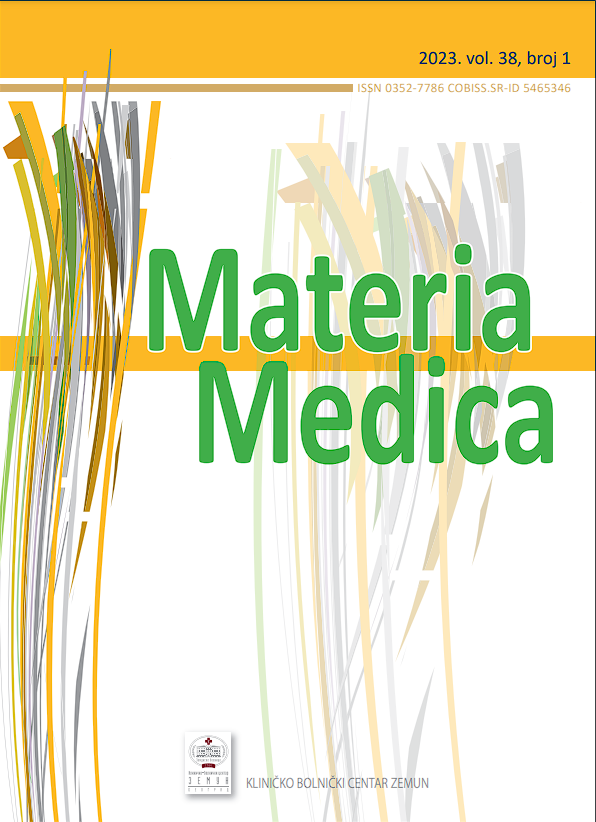Current issue

Volume 39, Issue 1, 2025
Online ISSN: 3042-3511
ISSN: 3042-3503
Volume 39 , Issue 1, (2025)
Published: 31.03.2025.
Open Access
Welcome to Issue 39, No. 1 – the first of our two annual publications for this year. Inside, you'll find a curated selection of articles. Start your year with the essential knowledge and perspectives offered in this timely edition
All issues
Contents
01.12.2017.
Review Article
Endokrine ćelije pankreasa u pacova hronično tretiranih kadfmijumom
Kadmijum (Cd) je mekan srebtrnasto-beli metal, jedan od 126 prioritetnih zagađivača, a svrstan je i u grupu humanih karcinogena I kategorije.Cilj rada je mikromorfološko i funkcionalno ispitivanje endokrinog pankreasa pacova hronično tretiranih kadmijumom. Za istraživanje su korišćeni beli Wistar pacovi ženskog pola, starosti 35-37 dana, težine 120-140 g.Ukupno je bilo 22 životinje koje su podeljene na kontrolnu (n=11) i eksperimentalnu grupu (n=11). Eksperimentalna grupa je svakodnevno tretirana sa 15mg/kg CdCl2 rastvorenog u pijaćoj vodi. Kontrolna grupa nije bila podvrgnuta nikakvom tretmanu. Svi pacovi su čuvani u kontrolisanim laboratorijskim uslovima. Posle tri meseca, sve životinje su žrtvovane. Tkivo pankreasa je rutinski obrađeno i kalupljeno u parafi n. Na 4μm presecima su primenjene HE i imunohistohemijska ABC metoda sa antitelima na: chromogranin A, insulin,glucagon,somatostatin, pankreasni polipeptid, i peptid YY. U životinja eksperimentalne grupe su nađene guste, hiperplastične B ćelije koje zaposedaju skoro čitavu površinu insule. Prisutna je i hiperplazija A ćelija sa izraženom funkcionalnom aktivnošću. Osim po obodu hiperplastičnih insula, pojedinačne A ćelije se nalaze i u acinusima u kojima je njihova aktivnost znatno povećana. Zapažen je povećan mitotski indeks i odsustvo citoplazmatskih produžetka D ćelija. Izražena je hiperplazija PP ćelija, sa znacima kako morfološkog tako i funkcionalnog polimorfi zma. Prisustvo PP ćelija je evidentirano i u hiperplastičnom i displastičnom epitelu većih duktusa. Samo u životinja eksperimentalne grupe smo našli ćelije koje sekretuju peptid YY. Ove ćelije imaju identičnu topografi ju kao i A ćelije, ali je njihov broj znatno manji. Hronično izlaganje kadmijumu remeti strukturu i funkciju endokrinog pankreasa.Sve pankreasne endokrine ćelije su pogođene.
Nina Jančić, Ivan Rančić, Janko Žujović, Velimir Milošević
01.12.2017.
Review Article
The misues of knoweledge: bioethics and security issues related to synthetic biology
The design and construction of new biological systems in the way engineers design electronic or mechanical systems is the primary goal of synthetic biology. The ability to create and modify life forms and easy access to information to do so has raised a number of issues related to ethics and security. In the era of rapid development of biotechnology, and the perception of the consequent risks to the environment and health, the ethics of knowledge becomes a matter of practical significance. The concern about the misuse of knowledge from synthetic biology influences new risk reduction strategies, which can have significant effects on scientific progress. This paper will provide an overview of the main bioethical and biosafety issues of synthetic biology.
Tatjana Marinković, Veljko Samardžić, Aleksandar Pajić, Dragan Marinković
01.12.2017.
Review Article
Inicijalni tretman politraumatizovanih pacijenata
Složeni problemi politraumatizovanih pacijenata su veliki izazov za lekare. Brojne povrede kod takvih pacijenata zahtevaju brzo reagovanje po principu prioriteta kojim se greške svode na minimum. Za lečenje trauma pacijenata neophodno je znanje, iskustvo i veština lekara da bi brzo i sveobuhvatno sagledao povređenog i da bi mu ukazao pravovremenu pomoć. Lečenje se izvodi fokusirajući se na prioritetne povrede pacijenta, prateći protokol postupaka koji lekara sistematski vodi tokom zbrinjavanja od najtežih ka lakšim povredama. Ovakve pacijente zbrinjava interdisciplinarni tim zdravstvenih radnika, u kome svako mora da zna svoje mesto i obaveze. Na čelu tima je najiskusniji lekar koji definiše redosled postupaka tokom inicijalnog zbrinjavanja. Samo organizovanim pristupom pandemijskom problemu trauma pacijenata može se pozitivno uticati na smanjenje neposrednog i odloženog mortaliteta i morbiditeta povređenih. U radu je revijalno prikazan pristup politraumatizovanom pacijentu uz inicijalno zbrinjavanje, baziran na prioritetima i prateći protokol koji obezbeđuje najveću efikasnost u lečenju.
Miljan Milanović, Vesna Stevanović, Zagor Zagorac, Rastko Živić, Aleksandar Lazić, Predrag Stevanović
01.12.2017.
Review Article
Atipična renalna cista koja imitira bubrežni karcinom: prikaz slučaja
Atipične ciste bubrega klasifikovane kaoBosniak III ili IV sususpektne na malignitet ali je u nekimslučajevima teško uspostaviti pravu dijagnozu uprkos savremenim radiološkim metodama i predložiti odgovarajući terapijski pristup. Evaluiramo slučaj komplikovane hemoragične bubrežne ciste kod 73 –godina starog pacijenta. Pacijent je primljen u našu bolnicu na dalju evaluaciju zbog nespecifičnih bolova u leđima i trbuhu i zbog hroničnih urinarnih infekcija. Ultrazvukom su verifikovane bilateralne ciste bubrega od kojih neke sa gustim sadržajem. Nakon CT pregleda jedna od tih cista je klasifikovana kao Bosniak II F, zbog diskretne opacifikacije zida ciste u jednom segmentu, dok je MR nalaz ukazao na suspektnu malignu leziju, pri čemu je opisana restrikcija difuzije intraluminalno, što ukazuje na prisustvo solidnog dela, te je pacijent nefrektomisan. Patohistološki pregled je verifikovao inflamiranu hemoragičnu cistu bez prisustva malignih ćelija. Atipična cista bubrega može odgovarati komplikovanoj cisti sa infekcijom ili krvarenjem, ali takođe i cističnom tumoru. Radiološki pregled često nije dovoljan za jasnu diferencijaciju. Lažno negativne biopsije kod cističnih promena su vrlo izvesne i često je neophodno izvršiti hiruršku intervenciju za preciznu dijagnozu.
Nataša Rakonjac, Nenad Janeski, Svetlana Kocić, Aleksandra Cvijović, Jovana Latov-Bešić, Vladimir Čotrić, Aleksandar Mandarić, Mirko Vasilski
01.12.2017.
Review Article
Möbius syndrome redefined
Moebius syndrome is rare and complex disorder which due to clinical expression poses a great challenge for pediatric anesthesiologist. The most significant problem for anesthesia, due to craniofacial malformations, is difficulties to provide a safe airway. The need for anesthesia is imposed sometime in the age of the newborn and later in childhood because of necessary diagnostic and surgical procedures. We present the case of a two-month old infant with Moebius syndrome, potential anesthetic implications, as well as the safe application of the caudal block as an anesthetics technique for operations of Achilles tendons and correction of congenital deformities of both feet.
Vesna Stevanović, Maja Šujica, Ana Mandraš
01.04.2018.
Special Session: Residents Session
Hyperostosis frontalis interna: case report
Introduction: Hyperostosis frontalis interna is progressive, irregular thickeness of the frontal bone s internal table. It has been associated with a wide range of syndromes, though we know now that it can occur as an independent entity. Etiology is still unclear, but the most probable hyphothesis is alteration of steroid sex hormons, proven in high frequency among postmenopausal women. It is mostly asympthomatic or it has been accidentally diagnosed after endocranial trauma or postmortal. Because of its progression, in some cases it can cause cerebral cortical compression and varible neurological symptoms. Case report: We present a case of 27 years-old women, hospitalized in Neurosurgical Clinic, because of severe headaches lasting for 3 month. The head CT scan showed a massive, expansive lesion in right frontal bone, with spearing of the superior sagittal sinus and skull midline. Bone bulging does not affect outer table of the frontal bone, but only diploic space and inner table. Pathological analysis of the frontal bone showed marked trabecular thickening both cortical and spongy bone, with corticalisation of spongy bone. Haversian canals showed reduction in number and size, and light fibrosis. The lamellas of the spongy bones were enlarged, with prominent interlamellar bridges and the reduction of interlamellar spaces.In purpose of closer determination of etiopathogenesis,we did immunohystochemical analysis of Estrogen, Progesteron and Androgen receptors in dural tissue. Immunohistohemical stain confirmed nuclear expression of Estrogen and Androgen receptors in dural fibroblasts.Progesterone receptors were negative on immune stain. Conclusion: These results could support the hormonal theory of the cause of hyperostosis frontalis interna.
Ljubica Simic, Savo Raicevic, Danijela Bracanovic, Danijela Djonic, Jelena Sopta
01.04.2018.
Special Session: Residents Session
Crosstalk between NCAM/FGFR and TGF-beta signalings: an in vitro study and evaluation of human kidney biopsies
Aim: Here, we explored the role of NCAM/FGFR1 signaling and pro-fibrotic gene expression signatures as initiating or driving forces of EMT program in cultured human proximal tubular epithelial cells. Introduction: Epithelial-to-mesenchymal transition (EMT) contributes to maladaptive repair and parenchymal damage during renal fibrosis. Based on previous reports, neural cell adhesion molecule (NCAM) and fibroblast growth factor receptor 1 (FGFR1) are both considered to be mechanistically involved in the EMT process. Material and Methods: By using an established in vitro model of EMT of the human proximal tubular epithelial cells (HK-2 cells) in response to TGF-β1 (10ng/mL) exposure, NCAM/FGFR1 signaling responses were analyzed by light microscopy, immune-labelling, qRT-PCR and scratch assays. Modulation of FGFR1 was induced using PD173074 (100nM). Distribution of TGF-β1 downstream effectors was assessed in HK-2 cells of the EMT program as well as in 50 biopsies of different human kidney diseases to explore their in vivo correlation. Results: EMT associated with morphological changes started 48h after TGF-ß1 treatment of the HK-2 cells and was clearly apparent after 72 hours, associated with loss of CDH1 (encoding E-Cadherin) and transcriptional induction of SNAI1 (encoding SNAIL), SNAI2 (encoding SLUG), TWIST1, MMP2, MMP9, CDH2 (encoding N-Cadherin), ITGA5 (encoding integrin-α5), ITGB1 (encoding integrin-β1), ACTA2 (encoding α-SMA) and S100A4 (encoding FSP1). After 24 hours of TGF-β1 exposure at the early stage of SPECIJALNA SESIJA: SESIJA SPECIJALIZANATA 7 MATERIA MEDICA • Vol. 34 • Issue 1, suplement 1 • april 2018. EMT program, transcriptional induction of several NCAM isoforms along with FGFR1 was observed, implicating a mechanistic link between NCAM/FGFR1 signaling and induction of EMT. These assumptions were further supported by the inhibition of the EMT program after specific blocking of FGFR1 signaling responses by PD173074. Moreover, there was evidence for an in vivo TGF-β1 pathway activation with EMT response signal signatures in diseased human kidneys in correlation to impaired renal excretory functions. Conclusion: Modulation of NCAM/FGFR1 signaling blocks the EMT program in cultured human proximal tubular epithelial cells. NCAM/FGFR1 signaling appears to be involved in initial phases of TGF-ß1 initiated EMT of tubular cells and thus could contribute to maladaptive repair and parenchymal damage during renal fibrosis.
Maja Zivotic, Gerhard A. Müller, Claudia Müller, Radomir Naumović, Jasmina Marković-Lipkovski
01.04.2018.
Special Session: Residents Session
Primary sinovial sarcoma of the lung - a case report
Introduction: Primary sinovial sarcoma (PSS) is a very rare malignancy in lung, although lung is the most common organ-based site for metastatic synovial sarcoma. It is a high grade malignant mesenchymal neoplasm showing variable epithelial differentation and characterized by a balanced translocation t(X, 18). Case report: We report a case of a 67- year-old male presented with long lasting cough, chest pain and fever. Chest radiography and computer tomography scan revealed a large well defined lung mass invading hilum of the lung, which was indicated for the lung resection. Histopatological examination showed high-cellulare spindle cell malignant tumor. Immunohistochemically,neoplastic cells were positive for vimentin, TLE-1, Bcl-2, focally positive for cytokeratin AE1/AE3, cytokeratin 7, cytokeratin 18, cytokeratin 19, EMA, calponin and negative for CK 5/6, S100, STAT6, CD34, SMA, Desmin, CD99 and CD 117, which determinate a diagnosis of monophasic PSS of lung. Specific translocation t(X, 18) was detected by fluorescent in situ hybridization (FISH). Conclusion: Diagnosis of PSS in lung may create various diagnostic challenges. It can be established only after exclusion of metastatic sarcoma of other localizations and spindle cell primary lung malignancies. Molecular testing proved to be very helpful or necessary when spindle cell synovial sarcoma was recognized in uncommon sites.
Marija Ninkovic, Jelena Sopta, Dusan Ristic, Goran Suricic
01.04.2018.
Special Session: Residents Session
Proliferation marker Ki-67 in early breast cancer
Aim: Determination of cut-off value for Ki67 index, it’s corelation in luminal breast carcinoma with patient’s age, tumor size, histological grade (HG), and expression of estrogen (ER) and progesterone (PR). Introduction: Breast cancer is a heterogeneous disease characterized by different morphology, immunohistochemical profile, clinical course and response to applied therapy. Ki67 proliferative index is one of the prognostic and predictive factors, whose methodological determination and analysis are still unstandardized. Material and Methods: Retrospectively, we analysed 120 pathohistological reports of patients who were treated in the period 01.01.2009. until 31.12.2011. at the Oncology Institute of Vojvodina, and to whom immunohistochemistry was proven luminal breast cancer (positive ER and PR, negative HER2), without axillary lymph node metastases. Results: The average patient’s age was 57.42±10.17 years; average tumor size 17.98±6.97mm; recurrence was registered in 8 (6.7%) patients with average recurrence time of 49±20.23 months. “Cut off” Ki67 value of prognostic significance for period without recurrence is 20.75%. For correlation testing χ2 and Kendal τ-b tests were used. It’s shown unsignificant relationship between Ki67 and patient’s age (p=0.401 and p=0.293), as well as the strength of expression ER (p=1.00, p=0.957) and PR (p=0.273, p=0.189). Significant correlation is present for Ki67 with size (p=0.035, p=0.20) and tumor’s HG (p=0.041, p=0.20). Conclusion: Breast carcinoma is heterogeneous disease, so it’s difficult to predict its course and outcome using standard histopathological factors and biomarkers. For prognostic-predictive purposes, it’s necessary to include additional biomarkers, where Ki67 stands out above all, whose high value correlates with factors of bad prognosis.
Tanja Lakic, Tatjana Ivkovic-Kapicl
01.04.2018.
Special Session: Residents Session
Histopathological analysis of the enteric nervous system in children with constipation
Aim: Determination of frequency of patologic findings and types of pathologic findings in enteric nerve plexus (ENP) in colon biopsies in children with impaired bowel motility, specifically chronic constipation. Introduction: Chronic constipation is relatively common in children, and is most often a functional disorder that is responsive to dietary regime treatment. Rarely, some cases require biopsy and histopathologic analysis of ENP. Materials and Methods: Research consists of 299 colon biopsies taken from children with impaired bowel motility. Biopsies were analysed in Institute of pathology, Medical faculty in Belgrade, in the period of time from the year 2008 to 2018. Data analysis included standard methods of descriptive and analytic statistics. Results: Number of analysed biopsies was 588. Biopsies were taken from 184(61,5%) boys and 115(38,5%) girls. Most common referral diagnosis for biopsy was Hirschspung’s disease (HD) (153/299, 51,2%). Pathologic changes in ENP were found in 46,1% of patients (138/299). Histopathologic analysis confirmed clinical suspicion for HD in 48,4%(74/153) of patients. Most frequent pathologic finding secondary to HD were immature ganglion cells (26/299, 8,7%), ectopic position of ganglia in muscle layer of colonic wall (6/299, 2%), and unclassified dysganglioses (5/299, 1,7%). In six patients, cause of constipation was eosinophilic proctitis and/or mienteric ganglionitis. Acetilcholin esterase as diagnositic metod was applied in 29 patients. Immunohistochemical analises were used in 24 patients. Conclusion: HD and immaturity of ganglion cells are by far most frequently diagnosed causes of constipation in colon biopsies in pediatric patients. Eosinophilic proctitis and/or mienteric ganglionitis are rare causes of constipation in children.
Jovan Jevtic, Milica Skender Gazibara, Sanja Sindic Antunovic, Marija Lukac, Dragana Vujevic, Milos Lazic, Radmila Jankovic









